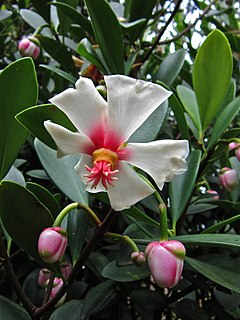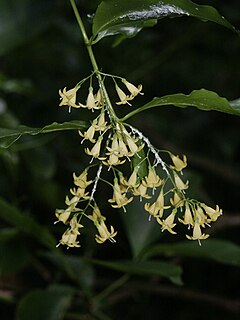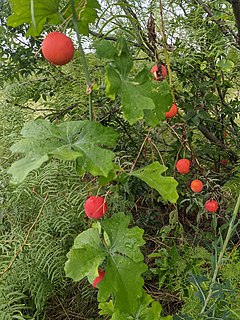
Tecun Uman was one of the last rulers of the K'iche' Maya people, in the Highlands of what is now Guatemala. According to the Kaqchikel annals, he was slain by Spanish conquistador Pedro de Alvarado while waging battle against the Spanish and their allies on the approach to Quetzaltenango on 12 February 1524. Tecun Uman was declared Guatemala's official national hero on March 22, 1960 and is commemorated on February 20, the popular anniversary of his death. Tecun Uman has inspired a wide variety of activities ranging from the production of statues and poetry to the retelling of the legend in the form of folkloric dances to prayers. Despite this, Tecun Uman's existence is not well documented, and it has proven to be difficult to separate the man from the legend.
Chamguava is a genus of the botanical family Myrtaceae, first described as a genus in 1991. It is native to southern Mexico and Central America.
- Chamguava gentlei(Lundell) Landrum - Chiapas, Belize, Guatemala, Honduras
- Chamguava musarum(Standl. & Steyerm.) Landrum - Guatemala
- Chamguava schippii(Standl.) Landrum - Guerrero, Chiapas, Belize, Guatemala, Panama

Neea is a genus of plants in family Nyctaginaceae from the Caribbean region, Central and South America. Members of the genus are commonly called Nia, Neea, or saltwood.

Paul Carpenter Standley was an American botanist known for his work on neotropical plants.
Julian Alfred Steyermark was a Venezuelan American botanist. His focus was on New World vegetation, and he specialized in the family Rubiaceae.
The Baile de la Conquista or Dance of the Conquest is a traditional folkloric dance from Guatemala. The dance reenacts the invasion led by Spanish conquistador Pedro de Alvarado and his confrontation with Tecun Uman, ruler of K'iche' kingdom of Q'umarkaj. Although the dance is more closely associated with Guatemalan traditions, it has been performed in early colonial regions of Latin America at the urging of Catholic friars and priests, as a method of converting various native populations and African slaves to the Catholic Church.
Conrad Vernon Morton was an American botanist who did notable writings on Ferns. He was also a specialist in Gesneriaceae and Solanaceae for the Smithsonian Institution from 1928.

Chiococca is a genus of flowering plants in the family Rubiaceae. It currently holds 23 species that are native to Florida, Texas, Mexico, Central America, much of South America, the West Indies, and the islands of Galápagos and Fernando de Noronha.

Tinantia is a genus of plants in the Commelinaceae, first described in 1839. They are commonly called widow's tears or false dayflowers due to their resemblance of the closely related true dayflowers of the genus Commelina. Tinantia is native to North and South America from Texas + Hispaniola to Argentina, with a center of diversity from Mexico to Nicaragua. Tinantia pringlei, an alpine native of Mexico, is grown as an ornamental in temperate areas and is also a common greenhouse weed.
Sebastiania cruenta is a species of flowering plant in the family Euphorbiaceae. It was originally described as Stillingia cruentaStandl. & Steyerm. in 1944. It is native to Mexico and Guatemala.
Steyermarkia is a monotypic genus of flowering plants belonging to the family Rubiaceae. It only contains one known species, Steyermarkia guatemalensisStandl.

Ibervillea is a genus of flowering plants belonging to the family Cucurbitaceae.
Ledenbergia is a genus of flowering plants belonging to the family Petiveriaceae.
Mortoniodendron is a genus of flowering plants belonging to the family Malvaceae.
Sommera is a genus of flowering plants belonging to the family Rubiaceae.
Rousselia is a genus of flowering plants belonging to the family Urticaceae.
Romanschulzia is a genus of flowering plants belonging to the family Brassicaceae.
Stanmarkia is a genus of flowering plants belonging to the family Melastomataceae.
Plowmania is a monotypic genus of flowering plants belonging to the family Solanaceae. The only species is Plowmania nyctaginoides.

Disocactus speciosus, the sun cactus, is a species of flowering plant in the family Cactaceae. It is native to Mexico, Honduras and Guatemala, and has been introduced to the Canary Islands. As its synonym Heliocereus speciosus it has gained the Royal Horticultural Society's Award of Garden Merit.






